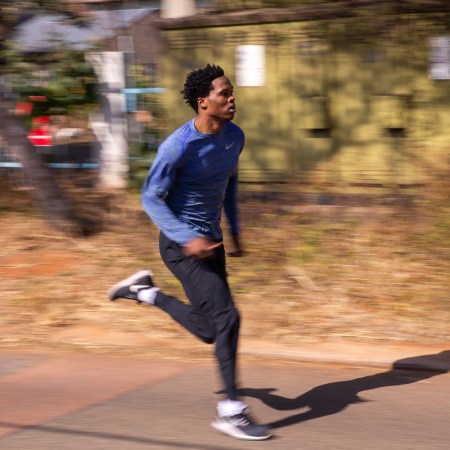Heading into my very first trampoline workout, I chose a corner of my backyard where none of my neighbors could peek through the bushes and spot a grown man hopping to remixes of aughts classics. I have no issue with working out in public — I’m a runner, and lift at a gym a few times a week — but something about bounce felt undignified and ineffectual, like an approximation of exercise for those who can never commit to a routine.
But a few minutes into my full-body ladder workout on The Ness, a swank, gold-rimmed mini trampoline, which has a corresponding app with dozens of bounce and sculpt workouts, I shoved my biases to the side. Working out on a trampoline is legit. Legit enough that I completely lost myself in the 30-minute scorcher, and would’ve been far too absorbed to notice any Ned Flanders-types over by the fence.
Bounce (also known as rebounding) has found on-and-off popularity since the early 1980s, when the class craze was first taking off across the States. The workout shares DNA with barre, Zumba and step aerobics — as a muscular endurance-cardio mix that’s meant to appeal to trainees in search of low-stakes, low-impact exercise — and once received a glowing endorsement from NASA, of all institutions, which concluded that “the magnitude of the bio mechanical stimuli is greater with jumping on a trampoline than with running.”
(This point was confirmed/expounded 35 years later in a study published in the International Journal of Sports Science, which found that consistent mini-trampoline use “may improve VO2 max, vertical jumping distance and reduce body fat percentage.” That said: just to temper the hype a little bit, there is no evidence that NASA ever stated “Rebound exercise is the most efficient, effective form of exercise yet devised by man,” a quote that rebound marketers have been known to invoke over the years.)
Bounce’s latest surge arrived during the pandemic, as almost every imaginable gym apparatus got the Peloton treatment. From climbing machines, to slide boards, to dumbbell racks masquerading as wall-mounted systems, you’d be hard-pressed to think of a single concentration that hasn’t been commoditized into a monthly subscription package. (At-home swimming tanks?) To that end: The Ness, like rival bounce platform Obé Fitness, charges a rate of $360 a year. That’s very hefty. Is it worth it? That depends on how you respond to trampoline fitness. If one thing’s for certain, a commitment to the cause will get you in ridiculous shape.
Unlike standard trampolines — the eyesores that break middle schoolers’ wrists at a prolific rate — rebounders aren’t built to hurl you high into the air. They’re actually fairly firm, and facilitate rapid movement in the lower half without putting unnecessary stress on the joints. While there are times during a bounce workout where you’ll get some decent vertical, that’s not really the aim; one of the exercise’s building block moves is actually called “bounce downs,” where you tuck in your ribcage, squeeze your core and glutes and perform short, staccato jumps down into the nylon.
Bounce demands control and concentration. Most mini trampolines are only three feet in diameter, so when an instructor asks you to jump back and forth (and perhaps add a twist to one side, while keeping your shoulders square to the front), that’s not a lot of room to work with, especially for a taller guy like me. Most of my early jumps had me overshooting, to one side or the other, but with time I learned to make my moves more economical and exacting. This sort of movement pays dividends, bolstering stability, lateral mobility and a crucial concept most of us abandon with age, called proprioception, which is your understanding of your body in space.
The mental component eases up once you learn the day’s moves (at a certain point you have the ladder memorized, and it comes down to responding to verbal cues, sort of like dancing), but the physical element hangs tough throughout. It’s a lot of time to be on your feet, especially when you’re spending that time doing jumping jacks, high knees, single leg hops, heel touches and jump squats. Some moves even call for a heel touch and a high kick, which, if you haven’t been stretching lately, will put you in your place right away. I was gassed by the end of my half hour, and felt it in every corner of my body.
Workouts like bounce often feel like they have more to prove, which feels unfair. That almost certainly stems from agist, genderized stereotypes, which view certain exercises as worthy of praise and others as dressed-up warmups. But bounce shouldn’t feel a need to convince fitness consumers that it burns more calories than running, or hits the glutes harder than spin. What it does extremely well is encourage fun, thoughtful, nonstop movement — the sort the average American is severely lacking in.
Personally, I don’t think you need a monthly subscription service to learn how to properly use a mini trampoline. There are plenty of videos online that’ll teach you the basics, and you can bring home a solid option for $75 that’ll likely perform as well as the fancy apparatus I sampled from The Ness. Plus: if you Google bounce classes in your area, you might be surprised. Leaving the confines of your backyard just might take some mental convincing, but you won’t regret it. Remember: the best exercise routine is a consistent one, but that doesn’t mean it has to be conventional.
The Charge will help you move better, think clearer and stay in the game longer. Subscribe to our wellness newsletter today.

























